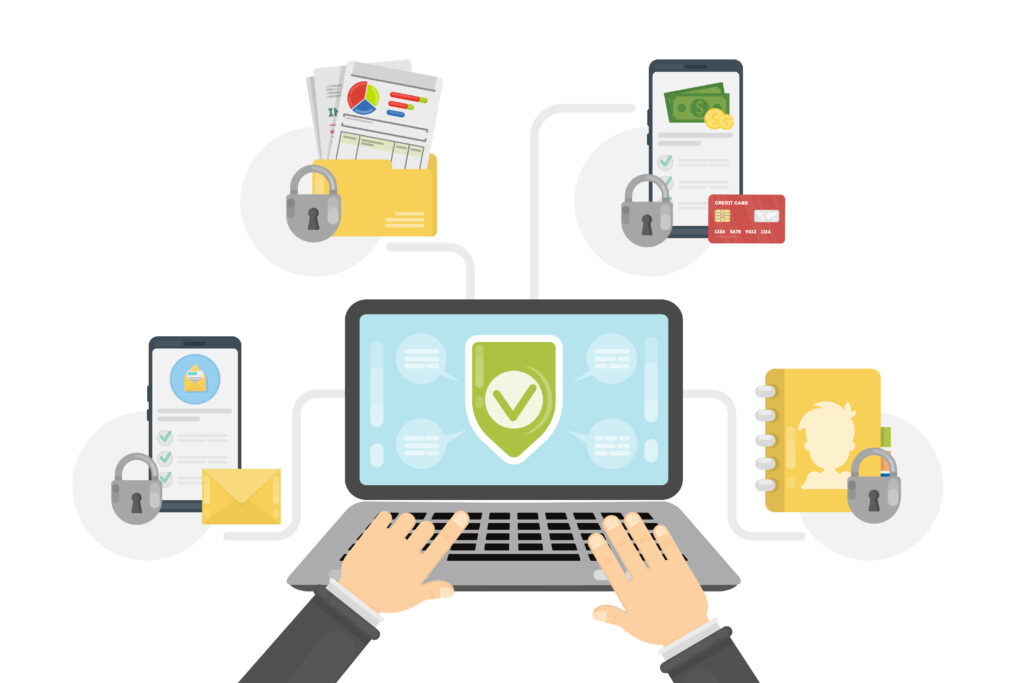In the digital age, information is power. And for financial institutions, the significance of data security cannot be overstated. From customer transactions and credit card details to sensitive business data, a breach can lead to colossal financial losses, eroded trust, and severe reputational damage. With a 67% increase in security breaches over the last five years, as reported by Accenture, the question is no longer ‘if’ a data breach will occur, but ‘when’. Hence, securing data has become the bedrock of operational resilience in the financial sector.
Understanding the Threat Landscape: Quantum and Classical Computers
Traditional cyber threats posed by classical computers continue to evolve and create challenges for data security. However, the arrival of quantum computing—predicted to be fully functional within the next 10-20 years by IBM—poses an unprecedented threat. These advanced computers can potentially crack conventional encryption methods in minutes, making them a potential risk for catastrophic breaches.
An Overview of Current Data Security Practices in Financial Institutions
Financial institutions today manage a vast amount of sensitive data that ranges from personal account information to intricate transaction details. As custodians of such invaluable information, they employ an intricate web of data security practices to safeguard these assets against increasingly sophisticated cyber threats.
A cornerstone of their defenses is firewall systems. These robust digital barricades serve as the first line of defense against unauthorized access, blocking malicious entities and preventing them from breaching the network. Coupled with anti-virus software, they scan and eliminate potential threats that may be embedded in data packets entering the system, thus protecting the network from harmful viruses, worms, and other forms of malware.
Another crucial data security measure used by financial institutions is multi-factor authentication (MFA). MFA adds an additional layer of security by requiring users to provide two or more independent credentials when accessing sensitive data. This method significantly reduces the likelihood of unauthorized access, even if one set of credentials is compromised.
Additionally, to ensure the secure transmission of data, encryption methods are employed. Encryption transforms data into a coded format, unreadable without the correct decryption key. It’s particularly important during data transfers where the risk of interception by malicious parties is high.
However, the rapidly developing field of quantum computing presents new challenges to these traditional methods of data security. Theoretically, quantum computers could decipher current encryption algorithms in a fraction of the time it would take a classical computer, potentially rendering existing security measures ineffective.
In response to this, financial institutions are exploring quantum-resistant encryption algorithms. These advanced systems are designed to withstand attacks even from quantum computers, bolstering the security measures already in place. Moreover, they are increasingly adopting AI and machine learning techniques for predictive threat analysis, behavior monitoring, and anomaly detection to proactively guard against cyber threats.
There is also an increased focus on staff training and fostering a culture of data security within these institutions. This human-centric approach helps in minimizing errors, improving awareness of phishing attempts, and promoting safe digital practices.
Despite these advancements, the field of data security in financial institutions is always evolving. With the perpetual advancements in technology and the corresponding escalation in cyber threats, financial institutions must continually update their practices, aiming not just to react to threats but to anticipate and neutralize them in advance.
The Risks and Shortcomings of Existing Data Transfer Protocols
The current ecosystem of data transfer protocols, including HTTPS, FTPS, and SFTP, to name a few, have served us reliably for years. However, with the impending threat of quantum computing, these protocols could be drastically compromised. Quantum computers, with their immense processing power, can crack the encryption methods currently in use, such as RSA and ECC, at an unprecedented rate, thus posing a significant risk to our digital security infrastructure.
It’s important to remember that while existing protocols have improved security over time, their core design wasn’t built to handle the advancements and challenges brought about by quantum computing. As a result, the basic principles of these protocols could be exploited, leading to data breaches and unauthorized data access. The repercussions of such security breaches could be detrimental, especially when it comes to sensitive data, such as financial, healthcare, or national security information.
Moreover, these protocols often rely on older technologies and standards, which can be incompatible or inefficient with newer, faster, and more secure technologies. For example, FTP and SFTP are heavily reliant on TCP, a transport protocol known for its reliability but not its speed. This can cause delays in data transfer, leading to inefficiencies in time-critical applications.
Existing protocols can be hindered by issues such as network latency, data corruption during transfer, and challenges with data synchronization when files are transferred across different platforms or systems. These problems often require additional layers of error-checking and correction, adding complexity and potential points of failure to the data transfer process.
Furthermore, many protocols also lack adequate data compression, which can result in inefficient bandwidth usage, especially when transferring large files or volumes of data. This not only slows down the transfer process but also increases the cost of data transmission, particularly in environments where bandwidth is a critical resource.
Therefore, with the increasing reliance on digital information and the ubiquity of data transfer, there is a growing need to rethink and redesign data transfer protocols. The focus should be on developing solutions that are resilient to the threats posed by quantum computing, while also addressing the performance, compatibility, efficiency, and cost issues that exist with current protocols.
Meet Blaze Transfer: The Quantum-Safe File Transfer Solution

Enter Blaze Transfer, a game-changer in secure data transfer. Blaze Transfer is a quantum-safe, end-to-end encrypted large file transfer platform designed to protect your data from all types of threats. Its hybrid encryption, known as BlazeHQ encryption, ensures your data is safe against both quantum computers and classical computers, offering the most secured encrypted file transfer solution on the market.
Blaze Transfer provides an extra layer of security to financial institutions. With its unique encryption technique, it eliminates the risk associated with data transfers, one of the most vulnerable stages of data handling. By adopting Blaze Transfer, financial institutions can ensure their data security protocols are ready to tackle future threats, including those from quantum computers.
How Blaze Transfer Works: A Step-by-Step Guide
At the heart of Blaze Transfer is user-friendliness. Despite its cutting-edge technology, Blaze Transfer provides an intuitive and straightforward user interface. Whether you’re sending large files or small packets of sensitive data, the process is simple: select your files, choose your recipients, encrypt your data, and send. Blaze Transfer takes care of the rest, ensuring your data reaches its destination securely and promptly.
Blaze Transfer is designed to be used by everyone, regardless of technical proficiency. The interface is visually intuitive, guiding users through each step of the data transfer process. Here’s a step-by-step guide:
- Select Your Files: This is your first step. Blaze Transfer supports a wide variety of file formats, from text documents and spreadsheets to high-resolution images and videos. You can upload files directly from your device or from a cloud storage service. Simply navigate through your folders and select the files you want to send. There’s no limit to the number of files you can select, providing you with a flexible platform for extensive data transfers.
- Choose Your Recipients: Once your files are selected, you’ll need to specify the recipients. You can add them manually by entering their email addresses or select them from your saved contacts. Blaze Transfer’s smart suggestion feature can help you quickly find and select your frequently contacted recipients.
- Encrypt Your Data: This is where Blaze Transfer stands out. Prior to sending your files, you have the option to encrypt them. This adds an extra layer of security, ensuring that only the intended recipient can access the sent data. Encryption is simple: you choose a secure password that will be used to decrypt the files on the receiving end. Blaze Transfer uses advanced encryption standards, assuring you that your data is protected.
- Send: Finally, with the press of a button, your files are sent. Blaze Transfer compresses your files for faster transmission, while preserving their quality and integrity. Once the files are sent, you receive a notification confirming the successful transfer.
The receiving end of Blaze Transfer is equally simple. Recipients receive an email notifying them of the incoming files. If the files are encrypted, they’ll be prompted to enter the password provided by the sender to decrypt and access them.
Moreover, Blaze Transfer incorporates a robust tracking system. As a sender, you can track when your files are downloaded by the recipient, providing you with a clear understanding of your data’s journey. If there are any delays or issues, Blaze Transfer’s customer support is always ready to assist.
Blaze Transfer’s mission is to make data transfer easy, fast, and secure. Its innovative features, combined with its straightforward process, ensure that it lives up to its mission every day.
Adapting to the Future- Quantum era
Quantum computing, with its potential to perform complex calculations at breakneck speeds, will redefine how businesses process and manage data. However, with great power comes significant risk, particularly in the financial sector where information security is of utmost importance. As quantum computers advance, they pose a considerable threat to conventional encryption algorithms, the bedrock of data security in the digital age. With a quantum computer, malicious actors could feasibly break current encryption methods, exposing sensitive data and undermining the stability of financial systems.
Given these potential vulnerabilities, it’s critical that financial institutions proactively adapt to the quantum computing era. This means not only understanding the risks but investing in quantum-safe security measures and tools. One such solution is Blaze Transfer, a quantum-resistant data transfer protocol designed to secure digital transactions and communications. Blaze Transfer, along with similar solutions, leverages cutting-edge cryptographic techniques resistant to quantum decryption, offering a bulwark against potential quantum cyber-attacks.
Moreover, adapting to the quantum computing era isn’t just about upgrading security protocols. It requires a cultural shift in how institutions perceive and manage risk. Proactive, forward-thinking strategies need to be the norm, with ongoing education and training initiatives to ensure everyone, from top-level executives to the front-line staff, understands the implications of quantum computing. Financial institutions should also consider establishing dedicated teams to monitor advances in quantum computing and cybersecurity, allowing them to stay ahead of potential threats.
By taking these steps, financial institutions can not only mitigate the risks of the quantum computing era but also seize its opportunities. After all, quantum computing isn’t just a threat – it’s also a potential game-changer. By leveraging its computational prowess, financial institutions can analyze vast quantities of data more quickly and accurately than ever before, unlocking new insights and enhancing decision-making capabilities.
Thus, as the quantum computing era dawns, the financial industry faces both challenges and opportunities. While the security risks are formidable, with careful planning, investment, and a proactive approach to risk management, financial institutions can equip themselves to thrive in this new landscape.
Conclusion
In conclusion, enhancing data security is a continual journey, especially for financial institutions handling sensitive data daily. Adopting solutions like Blaze Transfer is a strategic step in this direction. It’s a commitment to data protection that’s vital for maintaining trust, building reputation, and ensuring regulatory compliance. As quantum computing continues to evolve, the safety of your data will depend on staying ahead of the curve, and Blaze Transfer provides the means to do just that.
Remember, the threats are real, but so are the solutions. Protect your data today to safeguard your tomorrow. Blaze a trail to a safer future with Blaze Transfer!




